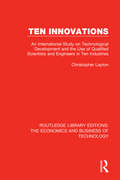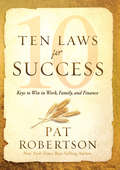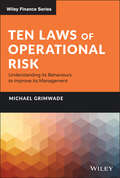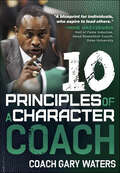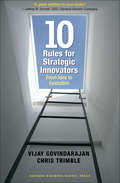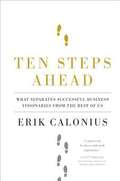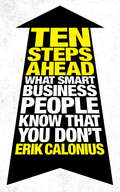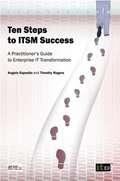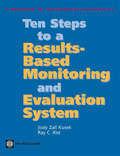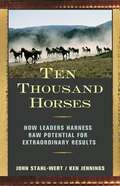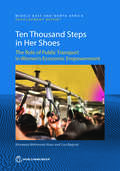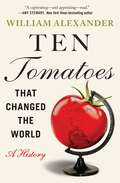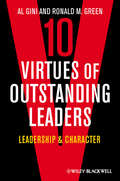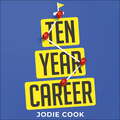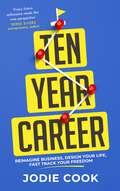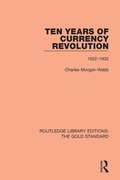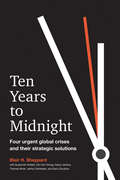- Table View
- List View
Ten Innovations: An international study on technological development and the use of qualified scientists and engineers in ten industries (Routledge Library Editions: The Economics and Business of Technology #28)
by Christopher LaytonOriginally published in 1972, this book examines ten major areas of innovation with a view to seeing what factors have contributed to success or failure. In each field 3 or 4 companies have been compared - from Britain, the USA and Europe. The book analyses and studies the results and discusses conclusions on the distinctive role of the small and large firm. It includes recommendations for governemnt policy on procurement and industrial structures.
Ten Laws for Success: Keys to Win in Work, Family, and Finance
by Pat RobertsonFrom Renowned Religious Leader and Host of The 700 Club, Pat Robertson. Know not just how the world works, but how it&’s supposed to work. This book will teach you ten overriding laws given by Jesus that will help you achieve your goals and bring about economic success for your family. Pat Robertson brings you a real-world guidebook that can revolutionize your life. Ten Laws for Success uncovers ten overriding laws given by Jesus Christ that are as powerful and constant as the law of gravity.These ten laws can help you:Lead a successful, prosperous, and meaningful lifeBring to your family blessing and economic successBuild unity to achieve your goalsDiscover winning principles of leadership and personal growthGrow in perseverance and reap its rewardsFind healing, financial blessing, and marital bliss &“I have learned that when Jesus Christ makes a clear statement that is not limited to time, place, or recipient, that statement becomes a fundamental law that is as powerful as a law of nature itself.&” —Pat Robertson
Ten Laws of Operational Risk: Understanding its Behaviours to Improve its Management
by Michael GrimwadeTEN LAWS OF OPERATIONAL RISK Unlike credit and market risk, operational risk currently lacks an overarching theory to explain how and why losses occur. As a result, operational risk managers have been forced to use unsatisfactory tools and processes that fail to add sufficient commercial value. In Ten Laws of Operational Risk: Understanding its Behaviours to Improve its Management, Michael Grimwade delivers an insightful discussion of the nature of operational risk and a groundbreaking redesign of the profession's existing tools. The author's Ten Laws are grounded on the business profiles of firms and the human and institutional behaviours that drive operational risk. They are underpinned by taxonomies for the causes; the inadequacies or failures that constitute both control failures and events; and the impacts of operational risks. Drawing on twenty-five years of first-hand experience and research, this book explains the patterns and trends that are apparent in the historical data and offers solutions to the persistent problems inherent in risk appetite, RCSAs, scenario analysis, reputational risk, stress testing, capital modeling, and insurance. It also provides fresh insights into the everyday activities of risk managers with respect to predictive key risk and control indicators, root cause analysis, why controls fail, the risks posed by change, and product risk profiles. Ten Laws of Operational Risk presents a structured and evidence-based approach to identifying emerging risks and predicting future behaviours related to pandemics, climate change, cybercrime, artificial intelligence, and machine learning. It includes revealing industry data, in-depth case studies, and real-world examples that shed light on recurring and obstinate problems in operational risk management. A must-read resource for Chief Risk Officers and other risk professionals, as well as regulators, management consultants, and students and scholars of operational risk, Ten Laws of Operational Risk provides an invaluable new, systematic, and rigorous approach to operational risk management. PRAISE FOR TEN LAWS OF OPERATIONAL RISK Operational Risk can no longer be described as a new concept, but as a discipline few attempts have been made to really understand its behaviour. In his book Michael does this very successfully, blending extensive practical experience with analytical thought leadership to propose a set of laws that explain why and how Operational Risks arise, and what can be done to manage them. Assertions are evidence based, with numerous real examples used to underpin his hypotheses. This is a valuable addition to Operational Risk thinking and is recommended for experienced professionals and novices alike.Dr Luke Carrivick, Director of Research & Information, ORX Michael has established himself as one of Operational Risk's foremost thinkers. His ability to use historical data to analyse events is unrivalled. In this must-read book, he identifies ten fundamental laws that provide every Operational Risk practitioner with a clear set of rules they can use to understand current events and predict their impacts.Andrew Sheen, former Head of the FSA's Operational Risk Review team Michael is one of the most prominent thinkers in Operational Risk. He combines a long career in Operational Risk management and measurement with a deep, long-standing reflection on the fundamental causes, dynamics and patterns in the manifestation of Operational Risk events. He produces, with this book, a remarkable synthesis of his insightful and innovative work.Dr Ariane Chapelle, Honorary Reader, University College London; Managing Partner, Chapelle Consulting Michael is a highly respected expert in the field of Operational Risk, who has developed some ground-breaking frameworks for analysing this risk and guiding better ri
Ten Principles of a Character Coach
by Coach Gary WatersTen Principles of a Character Coach provides clear experienced-based advice on how to be a character coach.Within Ten Principles of a Character Coach, Coach Gary Waters defines a character coach as someone who lives a life with integrity, honesty and moral values. He speaks specifically on how the sport of basketball has been riddled with scandals in recent years on the high school and college levels; and how the governing authorities are committed to repairing the reputation of college basketball. Ten Principles of a Character Coach addresses many of the issues that young men and women are experiencing in the athletic arena today. Coach Waters believes character and values need to be a high priority in those individuals tasked with guiding young people, as well as themselves. Furthermore, Coach Waters is convinced that following the principles within Ten Principles of a Character Coach will benefit anyone in developing their character.
Ten Rules Explained
by Chris Trimble Vijay GovindarajanUsing the story of Analog Devices and its efforts to develop a new technology for automotive crash sensors, in this chapter the authors summarize their advice as ten rules for strategic innovators. To commercialize the revolutionary crash sensors, the company's leadership team succeeded in overcoming the three challenges of forgetting, borrowing, and learning, ultimately becoming a profitable business that still has tremendous growth potential. This is an ideal demonstration that leading a strategic experiment using the ten rules is well within reach.
Ten Rules for Strategic Innovators
by Chris Trimble Vijay GovindarajanEven world-class companies, with powerful and proven business models, eventually discover limits to growth. That's what makes emerging high-growth industries so attractive. Although they lack a proven formula for making a profit, these industries represent huge opportunities for the companies that are fast enough and smart enough. But constructing tomorrow's businesses while simultaneously sustaining excellence in today's, demands a delicate balance. It is a quest fraught with contradiction and paradox. Until now, there has been little practical guidance. Based on an in-depth, multiyear research study of innovative initiatives at ten large corporations, Vijay Govindarajan and Chris Trimble identify three central challenges: forgetting yesterday's successful processes and practices; borrowing selected resources from the core business; and learning how the new business can succeed. The authors make recommendations regarding staffing, leadership roles, reporting relationships, process design, planning, performance assessment, incentives, cultural norms, and much more. Breakthrough growth opportunities can make or break companies and careers. Ten Rules for Strategic Innovators is every leader's guide to execution in unexplored territory.
Ten Steps Ahead
by Erik CaloniusBusiness visionaries like Steve Jobs and Richard Branson are the stuff of legend. Yet we fumble in describing what they actually do. TEN STEPS AHEAD explains how it's not that some people can magically see opportunities - it's that the rest of us are blind to the ones all around us. We learn, for instance: How Richard Branson had the foresight to trademark Virgin Galactic in the early 1990s, when private spaceflight was science fiction; How Richard Feynman made breakthroughs in quantum mechanics be pretending he was an electron; Why Jeff Hawkins walked around with a block of wood and a chopstick to design the first Palm Pilot. Erik Calonius, who has interviewed many of the greatest living visionaries across disciplines and industries, weaves together their stories, highlights their shared attributes, and draws on science to help us understand what sets them apart and how we too can see (and make) the future.
Ten Steps Ahead: What Smart Business People Know That You Don't
by Erik CaloniusBusiness visionaries like Steve Jobs and Richard Branson are the stuff of legend. Yet we fumble in describing what they actually do. TEN STEPS AHEAD explains how it's not that some people can magically see opportunities - it's that the rest of us are blind to the ones all around us. We learn, for instance:How Richard Branson had the foresight to trademark Virgin Galactic in the early 1990s, when private spaceflight was science fiction;How Richard Feynman made breakthroughs in quantum mechanics be pretending he was an electron;Why Jeff Hawkins walked around with a block of wood and a chopstick to design the first Palm Pilot.Erik Calonius, who has interviewed many of the greatest living visionaries across disciplines and industries, weaves together their stories, highlights their shared attributes, and draws on science to help us understand what sets them apart and how we too can see (and make) the future.
Ten Steps to ITSM Success
by Angelo Esposito Timothy RogersYou've read the books, but... A wealth of material has been written to describe the underlying mechanics of ITSM, but very little practical advice is available on how to implement ITSM best practices to achieve an organization's business objectives. The official ITIL® volumes explain what service management is, how the processes work and fit together, and why IT shops should adopt the practice, but they are notoriously vague on how to design and implement an ITSM model in a real organization. This challenge is best understood by those with experience of transforming ineffective and expensive IT, yet most ITSM guides are authored from a purely academic standpoint. From the classroom to the real world This book provides guidance on implementing ITSM Best Practices in an organization based on the authors' real-world experiences. Advice is delivered through a Ten-Step approach, with each step building upon the successes of its predecessors. Subjects covered include - • Documenting objectives, identifying current and future demands, analyzing service financials. • High-level design, negotiating development priorities, creating an execution plan and roadmap, agreeing roles and responsibilities. • Detailed design, building, testing, deploying. • Monitoring and continual improvement. Each step includes summary lists of key questions to ask and specific actions to take, and a useful business case template is included as an appendix. A practical guide to ITSM Improvement As organizations seek to boost revenue, cut costs and increase efficiency, they increasingly look to IT as a strategic partner in achieving these objectives. Ten Steps to ITSM Success helps IT to prepare for this role by providing a detailed and practical guide to implementing ITSM best practices. It is aimed at ITSM practitioners and consultants, but will also be of interest to IT Directors and C-suite executives looking to transform the role of IT into a value-creating business partner, to establish a service management culture, and to drive improvements in their respective organizations. A structured yet flexible method for achieving ITSM success!
Ten Steps to a Results-Based Monitoring and Evaluation System
by Jody Zall Kusek Ray C. RistAn effective state is essential to achieving socio-economic and sustainable development. With the advent of globalization, there are growing pressures on governments and organizations around the world to be more responsive to the demands of internal and external stakeholders for good governance, accountability and transparency, greater development effectiveness, and delivery of tangible results. Governments, parliaments, citizens, the private sector, NGOs, civil society, international organizations and donors are among the stakeholders interested in better performance. As demands for greater accountability and real results have increased, there is an attendant need for enhanced results-based monitoring and evaluation of policies, programs, and projects. This Handbook provides a comprehensive ten-step model that will help guide development practitioners through the process of designing and building a results-based monitoring and evaluation system. These steps begin with a "Readiness Assessment" and take the practitioner through the design, management, and more importantly, the sustainability of such systems. Ten Steps to a Results-Based Monitoring and Evaluation System describes each step in detail, the tasks needed to complete each one, and the tools available to help along the way.
Ten Thousand Horses: How Leaders Harness Raw Potential for Extraordinary Results
by Ken Jennings John Stahl-WertMatt James is in trouble. Recently promoted to head his division, he has delivered two years of divisional losses in clients, market share, and profits. He knows his workers are talented and creative, but they don't respond to his efforts to lead them, and he's on the brink of being fired. In desperation, he reaches out to an old mentor, David Butler, who now works with wild mustang horses and hard-to-place foster children on a ranch in Colorado. David agrees to work with his former student but only on the condition that Matt comes to him--to the ranch. Matt has no idea what the ranch could possibly have to do with his problems, but David assures him that if he spends some time there, he'll learn exactly what he needs to know. Through David's unorthodox tutelage, Matt discovers that leaders who succeed in engaging their workers do so because they see their day-to-day work as an opportunity to build an organizational culture of engagement. The engagement model is illuminated as Matt comes to understand its components piece by piece--and ultimately discovers how to engage those on his team and in his life. In this inspiring leadership fable, John Stahl-Wert and Ken Jennings draw on their years of experience as consultants and chief executives, as well as on findings from Gallup's groundbreaking Q12 survey of 4 million workers from 360,000 workgroups, to lay out an innovative leadership model that will turn employees from dutiful drones to committed contributors. But Ten Thousand Horses is also a story of personal transformation. Beyond specific practices and techniques, Matt must learn a whole new way of relating to his employees--because, as he discovers, leading an engaged workforce is as much about who you are as what you do.
Ten Thousand Steps in Her Shoes: The Role of Public Transport in Women’s Economic Empowerment (MENA Development Report)
by Muneeza Mehmood Alam Lisa BagnoliWomen around the world face numerous mobility challenges. Public transport can provide many economic benefits that should be enjoyed equally by all users, regardless of gender or life circumstances. In the Middle East and North Africa (MENA) region, women have a higher university enrollment rate than men, yet their labor force participation rate remains low and stagnant. What is preventing them from translating their educational achievements into economic productivity? Is it a matter of personal preference or structural barriers, or is it both? Although public transport systems can play a significant role in women’s participation in the labor force globally, this topic has been little explored in the MENA region. Ten Thousand Steps in Her Shoes: The Role of Public Transport in Women’s Economic Empowerment examines the role of public transport in women’s access to economic opportunities in urban MENA. The book studies the links among mobility, gender, and access to economic opportunities and focuses on three metropolitan areas--Amman, Jordan; Beirut, Lebanon; and Cairo, the Arab Republic of Egypt. Chapters focus on the availability of public transport close to households and employment centers, accessibility to job opportunities, affordability, social and cultural norms, and safety from crime and harassment. Data collected in 2022 reveal that a significant percentage of non-working women in urban MENA lack affordable, comfortable, safe, time-efficient, and reliable transport options, thus preventing them from seeking work. Women can contribute significantly to the economy. Improving public transport and tailoring it to the needs of various communities can help women be economically active. In addition, providing flexible work arrangements that support balancing personal, family, and work lives; protecting women from gender-based discrimination; and offering high-quality childcare options near where people work or live are key. However, gender equity in transport use can be only partially accomplished through well-intentioned policy interventions. Public awareness and endorsement of the benefits of greater gender equality—within households, workplaces, and society at large--are also crucial to advancing women’s participation in the economy. The analysis and recommendations presented in this report will help policy makers in Jordan, Lebanon, and Egypt design concrete actions, improve women’s mobility through public transport, and create an enabling environment to increase female economic participation.
Ten Tomatoes that Changed the World
by William AlexanderNew York Times bestselling author William Alexander takes readers on a surprisingly twisty journey through the history of the beloved tomato in this fascinating and erudite microhistory. The tomato gets no respect. Never has. Stored in the dustbin of history for centuries, accused of being vile and poisonous, appropriated as wartime propaganda, subjected to being picked hard-green and gassed, even used as a projectile, the poor tomato is the Rodney Dangerfield of foods. Yet, the tomato is the most popular vegetable in America (and, in fact, the world). It holds a place in America's soul like no other vegetable, and few other foods. Each summer, tomato festivals crop up across the country; John Denver had a hit single titled "homegrown Tomatoes;" and the Heinz tomato ketchup bottle, instantly recognizable, is in the Smithsonian. Author William Alexander is on a mission to get tomatoes the respect they deserve. Supported by meticulous research but told in a lively, accessible voice, Ten Tomatoes that Changed the World will seamlessly weave travel, history, humor, and a little adventure (and misadventure) to follow the tomato's trail through history. A fascinating story complete with heroes, con artists, conquistadors and, no surprise, the Mafia, this book is a mouth-watering, informative, and entertaining guide to the good that has captured our hearts for generations.
Ten Types of Innovation: The Discipline of Building Breakthroughs
by Larry Keeley Ryan Pikkel Helen Walters Brian QuinnInnovation principles to bring about meaningful and sustainable growth in your organizationUsing a list of more than 2,000 successful innovations, including Cirque du Soleil, early IBM mainframes, the Ford Model-T, and many more, the authors applied a proprietary algorithm and determined ten meaningful groupings--the Ten Types of Innovation--that provided insight into innovation. The Ten Types of Innovation explores these insights to diagnose patterns of innovation within industries, to identify innovation opportunities, and to evaluate how firms are performing against competitors. The framework has proven to be one of the most enduring and useful ways to start thinking about transformation.Details how you can use these innovation principles to bring about meaningful--and sustainable--growth within your organizationAuthor Larry Keeley is a world renowned speaker, innovation consultant, and president and co-founder of Doblin, the innovation practice of Monitor Group; BusinessWeek named Keeley one of seven Innovation Gurus who are changing the fieldThe Ten Types of Innovation concept has influenced thousands of executives and companies around the world since its discovery in 1998. The Ten Types of Innovation is the first book explaining how to implement it.
Ten Virtues of Outstanding Leaders
by Ronald M. Green Al GiniWhat makes a good leader? Ten leaders, ten key virtuesThis readable distillation of the core common features of successful leaders shows how an individual's character, and especially their virtue, is the defining factor. Without these ten vital virtues, leadership becomes "misleadership." The authors, both renowned business ethicists, combine theory with fascinating biographical detail on exemplary leaders such as Abraham Lincoln, Winston Churchill, and Oprah Winfrey. The result is an accessible text on the ethics of leadership which, unlike many publications that claim to reveal the secrets of success as a leader, is informed by a wealth of exceptional academic experience.
Ten Worlds of Welfare Capitalism: A Global Data Analysis
by Christian AspalterThis book presents a new step farther into the twenty-first century, for the first time truly combining a comprehensive global data analysis with social policy theory development. The theory of global ideal-typical welfare regimes, also known as the “Ten Worlds of Welfare Regime Theory”, as set forth earlier by Christian Aspalter, is now in this book tested empirically using a quantitative global data analysis for the first time. The strong and rich results fully vindicated the Ten Worlds Theory. All in all, about 150 countries are included in this test, measuring numerous variables on two main dimensions, i.e., povertization and inequality. The innovative approach of using a new indicator, Aspalter’s Standardized Relative Performance Index, is applied, which facilitated the exact measurements of distances between relative performances of each variable, each dimension, each country, and each ideal-typical welfare regime (in relation to one another, respectively). In addition, one explanative and one normative meta-study is added to the book, to point to ways to understand and deal with the global culprit of inequality and, hence, poverty.“On the backdrop of decades of comparative theoretical and empirical research we now, for the first time, have a truly global analysis of welfare regimes.” ---- Peter Abrahamson, Department of Sociology, University of Copenhagen
Ten Year Career: Reimagine Business, Design Your Life, Fast Track Your Freedom
by Jodie CookReimagine your future, adjust your efforts, jump into action and work for just ten more years before doing what the hell you want!Building a business can be confusing. Entrepreneurs aren't sure whether to keep control or delegate and automate, say yes or say no, work all hours or prioritise work-life balance. They take advice from all directions and wind up feeling overwhelmed and overworked without a finish line in sight.The TEN YEAR CAREER turns that premise upside down and argues that it doesn't have to be that way. If you have intention, focus, a willingness to question received truths and the vision to think big, you can emulate the world's most successful entrepreneurs and retire in ten years, no matter where you are in your career today.You'll learn: - How to define success your way, not their way.- How to achieve far more in a shorter space of time.- How to run your business without it running you.- The four-step framework by which to complete your Ten Year Career.You can achieve much more than you do now, in much less time than you thought, to reach financial freedom earlier than you imagined. That freedom, in turn, leads to the freedom to choose how you spend your days. The freedom to do whatever you want, with whomever you want, when you want to do it. The freedom to live life on your own terms.(P) 2022 Hodder & Stoughton Limited
Ten Year Career: Reimagine Business, Design Your Life, Fast Track Your Freedom
by Jodie Cook"A powerful and valuable book to live a life of greater freedom and impact", Robin Sharma, #1 worldwide bestselling author of The 5AM Club and The Everyday Hero ManifestoReimagine your future, adjust your efforts, jump into action and work for just ten more years before doing what the hell you want!Building a business can be confusing. Entrepreneurs aren't sure whether to keep control or delegate and automate, say yes or say no, work all hours or prioritise work-life balance. They take advice from all directions and wind up feeling overwhelmed and overworked without a finish line in sight.The TEN YEAR CAREER turns that premise upside down and argues that it doesn't have to be that way. If you have intention, focus, a willingness to question received truths and the vision to think big, you can emulate the world's most successful entrepreneurs and retire in ten years, no matter where you are in your career today.You'll learn: - How to define success your way, not their way.- How to achieve far more in a shorter space of time.- How to run your business without it running you.- The four-step framework by which to complete your Ten Year Career.You can achieve much more than you do now, in much less time than you thought, to reach financial freedom earlier than you imagined. That freedom, in turn, leads to the freedom to choose how you spend your days. The freedom to do whatever you want, with whomever you want, when you want to do it. The freedom to live life on your own terms.
Ten Year Career: Reimagine Business, Design Your Life, Fast Track Your Freedom
by Jodie Cook"A powerful and valuable book to live a life of greater freedom and impact", Robin Sharma, #1 worldwide bestselling author of The 5AM Club and The Everyday Hero ManifestoReimagine your future, adjust your efforts, jump into action and work for just ten more years before doing what the hell you want!Building a business can be confusing. Entrepreneurs aren't sure whether to keep control or delegate and automate, say yes or say no, work all hours or prioritise work-life balance. They take advice from all directions and wind up feeling overwhelmed and overworked without a finish line in sight.The TEN YEAR CAREER turns that premise upside down and argues that it doesn't have to be that way. If you have intention, focus, a willingness to question received truths and the vision to think big, you can emulate the world's most successful entrepreneurs and retire in ten years, no matter where you are in your career today.You'll learn: - How to define success your way, not their way.- How to achieve far more in a shorter space of time.- How to run your business without it running you.- The four-step framework by which to complete your Ten Year Career.You can achieve much more than you do now, in much less time than you thought, to reach financial freedom earlier than you imagined. That freedom, in turn, leads to the freedom to choose how you spend your days. The freedom to do whatever you want, with whomever you want, when you want to do it. The freedom to live life on your own terms.
Ten Years of Currency Revolution: 1922-1932 (Routledge Library Editions: The Gold Standard #7)
by Charles Morgan WebbOriginally published in 1935, this book charts the revolution from a banking to an industrial conception of currency which took place between 1922 and 1932. Having failed to stabilise the purchasing power of gold, General Strong stabilised the purchasing power of the dollar, an idea which was revived on an international scale by the Ottawa Conference of 1932. The stabilisation of purchasing power, independently of gold, was subsequently adopted as the keystone of British currency policy.
Ten Years to Midnight: Four Urgent Global Crises and Their Strategic Solutions
by Blair H. Sheppard"Shows how humans have brought us to the brink and how humanity can find solutions. I urge people to read with humility and the daring to act."—Harpal Singh, former Chair, Save the Children, India, and former Vice Chair, Save the Children InternationalIn conversations with people all over the world, from government officials and business leaders to taxi drivers and schoolteachers, Blair Sheppard, global leader for strategy and leadership at PwC, discovered they all had surprisingly similar concerns. In this prescient and pragmatic book, he and his team sum up these concerns in what they call the ADAPT framework: Asymmetry of wealth; Disruption wrought by the unexpected and often problematic consequences of technology; Age disparities--stresses caused by very young or very old populations in developed and emerging countries; Polarization as a symptom of the breakdown in global and national consensus; and loss of Trust in the institutions that underpin and stabilize society. These concerns are in turn precipitating four crises: a crisis of prosperity, a crisis of technology, a crisis of institutional legitimacy, and a crisis of leadership.Sheppard and his team analyze the complex roots of these crises--but they also offer solutions, albeit often seemingly counterintuitive ones. For example, in an era of globalization, we need to place a much greater emphasis on developing self-sustaining local economies. And as technology permeates our lives, we need computer scientists and engineers conversant with sociology and psychology and poets who can code. The authors argue persuasively that we have only a decade to make headway on these problems. But if we tackle them now, thoughtfully, imaginatively, creatively, and energetically, in ten years we could be looking at a dawn instead of darkness.
Tencent
by John R. Wells Gabriel EllsworthTencent had undergone many transformations since it was founded in 1998 as a simple messaging service. In 2017, it was the largest online games provider in China with a wide range of game types, China's largest social networking service provider with several of the largest social networking applications in the world, and China's favorite Internet portal. It was challenging Alibaba's Alipay as the leader in online payments systems, and it had established strategic relationships with many service providers to help exploit new opportunities in online-to-offline (O2O) services and leverage its huge user base in e-commerce and search. However, there was no room for complacency. Competition from the other big local Internet companies such as Baidu and Alibaba was fierce, and there were always thousands of start-ups looking to enter the sector. Founder and CEO Ma Huateng ("Pony" Ma) remarked, "In America, when you bring an idea to market you usually have several months before competition pops up, allowing you to capture significant market share. In China, you can have hundreds of competitors within the first hours of going live. Ideas are not important in China-execution is."
Tencent: Combining Technology and Culture
by Elie Ofek Dawn Lau Billy ChanTencent, one of the largest Internet conglomerates in China, had a vision to become a "Tech+Culture" firm. With dominant market shares in online games and social networking, it had built a vast Internet-based entertainment ecosystem, and was now focused on cultural asset development. Specifically, the company had an opportunity to develop a media franchise that was rich in Chinese cultural elements and had the potential to turn into a blockbuster franchise comparable with Disney's Marvel Cinematic Universe. Edward Cheng, the company's vice president, had to decide how to launch the franchise - whether it should start with a game, movie, a streamed series, or something more innovative. He also had to consider how to promote Chinese culture and project the country's image to a foreign audience.
Tenet Healthcare and Conifer Health Solutions
by Robert F. Higgins Jeet GuramThis case explores the relationship between Tenet Healthcare, the third largest for-profit hospital chain, and its subsidiary Conifer Health Solutions, a health services company. Conifer's IT programs help health care providers with revenue cycle management and population health management; the case provides an overview of both sectors. Conifer has been growing rapidly, leading some to question what the best relationship is for Tenet and Conifer going forward. The current parent-subsidiary arrangement presents synergies as well as potential conflicts.
Tengion: Bringing Regenerative Medicine to Life
by Elie Ofek Polly Ross RibattTengion is a young biotech company that is at the frontier of regenerative medicine; a nascent field that seeks to promote the creation of new cells and tissue to repair or replace tissue or organ function lost due to age, disease, damage, or congenital defects. In late 2008 Tengion management faces a difficult dilemma. In light of the financial crises, the company needs to manage cash burn by prioritizing its R&D efforts. CEO Nichtberger needs to recommend to the board which of two promising new medical treatments to keep developing while placing the other on hold. In comparing the two options, a host of factors need to be considered-- these range from assessing the regulatory challenges, manufacturing challenges, marketing challenges (in particular pricing), and partnering challenges. Each of the treatments would target a unique patient population, that differ in both size and composition. Tengion must also consider how quickly it might expect to bring each of the two treatments to market. The decision could have significant long-term implications for the company's ultimate survival and success.
